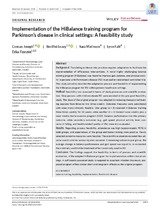| dc.contributor.author | Joseph, Conran | |
| dc.contributor.author | Leavy, Breiffni | |
| dc.contributor.author | Mattsson, Sara | |
| dc.contributor.author | Falk, Lynn | |
| dc.contributor.author | Franzén, Erika | |
| dc.date.accessioned | 2018-06-26T06:55:51Z | |
| dc.date.available | 2018-06-26T06:55:51Z | |
| dc.date.issued | 2018 | |
| dc.identifier.citation | Jospeh, C. et al. (2018). Implementation of the HiBalance training program for Parkinson’s disease in clinical settings: A feasibility study. Brain and Behavior, e01021. | en_US |
| dc.identifier.issn | 2162-3279 | |
| dc.identifier.uri | https://doi.org/10.1002/brb3.1021 | |
| dc.identifier.uri | http://hdl.handle.net/10566/3833 | |
| dc.description.abstract | BACKGROUND: Translating evidence into practice requires adaptation to facilitate the
implementation of efficacious interventions. A novel highly challenging balance
training program (HiBalance) was found to improve gait, balance, and physical activity
in persons with Parkinson’s disease (PD) in an earlier randomized controlled trial.
This study aimed to describe the adaptation process and feasibility of implementing
the HiBalance program for PD within primary healthcare settings.
METHOD: Feasibility was assessed in terms of study processes and scientific evaluation.
Nine persons with mild–moderate PD were enrolled in this pre–post feasibility
study. The dose of the original program was adapted by reducing therapist-led
training
sessions from three to two times weekly. Outcome measures were substituted
with ones more clinically feasible. One group (n = 5) received HiBalance training
three times weekly for 10 weeks while another (n = 4) trained twice weekly plus a
once weekly home exercise program (HEP). Balance performance was the primary
outcome, while secondary outcomes (e.g., gait speed, physical activity level, concerns
of falling, and health-related
quality of life) were also evaluated.
RESULTS: Regarding process feasibility, attendance was high (approximately 90%) in
both groups, and experiences of the group and home training were positive. Newly
selected outcome measures were feasible. The scientific evaluation revealed few adverse
events and no serious injuries occurred. Concerning outcomes per group, the
average change in balance performance and gait speed was equal to, or exceeded,
the minimally worthwhile treatment effect commonly used in PD.
CONCLUSION: The findings support the feasibility, in terms of process and scientific
evaluation, of the adapted HiBalance program for implementation within clinical settings.
A sufficiently powered study is required to ascertain whether the newly proposed
program offers similar short and long-term
effects as the original program. | en_US |
| dc.language.iso | en | en_US |
| dc.publisher | Wiley Open Access | en_US |
| dc.rights | This is an open access article under the terms of the Creative Commons Attribution License, which permits use, distribution and reproduction in any medium,
provided the original work is properly cited.
© 2018 The Authors. Brain and Behavior published by Wiley Periodicals, Inc. | |
| dc.subject | Balance training | en_US |
| dc.subject | Feasibility | en_US |
| dc.subject | Implementation | en_US |
| dc.subject | Parkinson’s disease | en_US |
| dc.title | Implementation of the HiBalance training program for Parkinson’s disease in clinical settings: A feasibility study | en_US |
| dc.type | Article | en_US |
| dc.privacy.showsubmitter | FALSE | |
| dc.status.ispeerreviewed | TRUE | |

